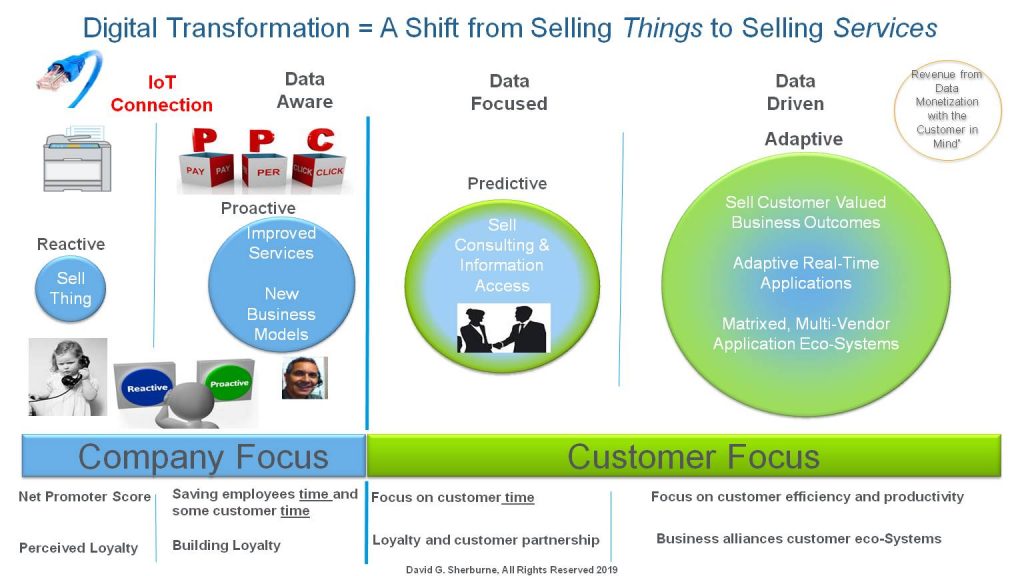
Image : Selling Thngs to Selling Services Model
This is a model I developed to visualize the opportunity space that may exist in your marketplace. The first circle represents the current state of many businesses today and the following three circles are the stages of digital transformation. Their size reflects the increasing revenue opportunities that exist as companies progress left to right in their thinking and approach to the customer and marketplace. It has been published that revenue from services will far surpass revenue from selling discrete things and margins for services are usually much higher than product margins. Digitally transforming a company may take time and energy but can yield very large future revenue streams.
The left-hand side of the model shown in blue represents internally focused opportunities that exist for most businesses today. Internally focused means that the primary focus is still inside the company and less on the customer. Internal focus has been the way many companies have seen the world for a very long time so its a good place for many companies to start their digital transformation efforts because they can visualize them more easily.
The right-hand side of the model indicated by the greenish blue colors highlights an increasing focus on the customer and less of a focus on the internal operational benefits to the company. This is the area where digital transformation will begin to bring benefits to the customers and the company simultaneously. It will be the subject of part 2 of this article.
Let’s take apart the model a little bit more;
In the first circle, is the incumbent way of doing business, the customer is the sensor, they own the device and they have to call you to get what they need resolved when something goes wrong. This is the way businesses ran in the not so distant past. Use the customer’s precious time to tell the service arm of a business what is wrong, making your customer the sensor and the communications conduit. Service folks were nice and the experience was at times pleasant but the fact is no one wants to deal with a problem. That was the norm 10 years ago, today wasting the time of your customer for this type of a process is no longer acceptable with the technology that exists at your finger tips.
The first step it to get an IoT Connection to your product and become data aware. That data awareness can be used to become better at reacting to problems and studying existing issues so that over time your service department can learn to become PROACTIVE instead of REACTIVE. Using simple data to improve service events for the customer is not a huge leap technology wise but can provide big benefits. A proactive service event that eliminates the down time for the customer or reduces the effort to resolve a problem is the first stage of the digital service evolution. It is where a lot of companies start because it’s manageable and impacts mostly internal resources and yields quick positive support from the customer base. It is the easiest way to leverage data and begin your transformation.
At this same level of maturity companies can consider shifting the selling model towards a lease or pay per use model (Servitization). This is a natural step that is still focused internally but takes advantage of data to improve visibility to the situation on the ground at the customers location and improve or extend the services offered to the customer. At this stage as an example the company can offer to take on more responsibility for the equipment (own the service) or help deliver the consumables when they are needed saving the customer time. Moving into pay per click model allows companies to take some additional revenue points by making it easier for customers to get to what they need when they need it. Customers no longer have to mange the ordering, inventory or know their consumption patterns, this can be done for them. If the customer leases the equipment in a pay per use business model then if the machine does not run then the company looses revenue and the customer is no longer the sensor or the conduit to the company. The more proactive at understanding the problems with a device the more profitable this transition step can be.
This blue half of the diagram we just examined is usually the starting position for digital transformation and companies can improve themselves internally saving both CUSTOMERS AND INTERNAL employees TIME. What internally focused companies may not see is there is another opportunity space based on focusing the data being gathered on the customer and becoming more focused on helping customers be more successful with their own operations. I will discuss this half of the model in my next blog!
( See Part 2)
